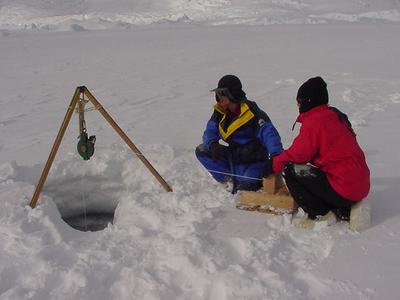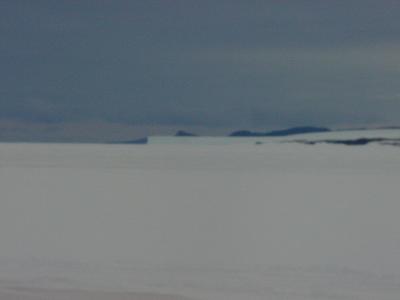2 December, 2000
FYI answer for 12/01/00
The first base built in Antarctica for the purpose of scientific research was a meteorological station built back in 1903. The United States built the Amundsen-Scott South Pole base in 1956-1957. McMurdo Station was built in 1955-1956 and Palmer Station was established in 1965.
The weekend started with good weather and a hodge-podge of tasks to complete. Our first was to collect more tissue samples from animals at Big Razorback that may not have been collected previously. These tissue samples are being used for the genetics study to see what DNA relationships in colony populations exsist. There is a pliers type tool that you approach from the tail of the seal. The tool has to grab tissue from the tail flipper. It is like a paper punch and takes a one to two centimeter patch of the seal's flipper. It is placed into a vial and marked. Later that day, it is put into ethanol alcohol until it will be used by another researcher later this season. The tail flipper bleeds more when the temperatures are warmer. Colder temperatures cause less bleeding. It is certainly not an incredible amount or dangerous for the seals.
The next task today was to head to Turks Head and see if we could round up the detachments that we needed. We ended up doing an impromptu census. We didn't see the seals we needed so we traveled down the area and came back to see if they had surfaced. We also finished measuring depths along the crack and the cliff. There was still no sign of our seals. We returned to Big Razorback at an early afternoon hour. The census crew was out at Barnes Glacier to tag seals out of the study area. Gifford and I took off on the snowmobiles to join them. We weren't able to make radio contact and when we got there they weren't there. We went ahead and took some photos and chipped sme blocks of the glacier ice and went back to camp. The glacier ice is fresh water ice so we can chip it into small pieces and use it to make our juices cold.
There is always ice to be chipped away from the camera ice hole, so I walked out there and worked on it for about a half-hour. I went by myself this time just to work at a slow pace and enjoy listening to the seals make noises on the ice and under the ice. There are many times when I'm in bed at night when I can hear the seals and their vocalizing under the ice. My first night here, I remember thinking I was going crazy. I was hearing seal noises, under my bed. It is possible and I've heard it a number of times since.
FYI
Scientists have documented increased _______________ radiation (UVR) in Antarctica due to depletion in the ___________ layer. Ultraviolet radiation exposure increases with the __________ of day (greatest between 10am and 3pm), season (greater in the _____________),altitude, and weather (increased by wind). Snow and ice reflects 85% of UVR.

Measuring the water depths at crack openings

This is Barnes Glacier looking from our camp
Contact the TEA in the field at
.
If you cannot connect through your browser, copy the
TEA's e-mail address in the "To:" line of
your favorite e-mail package.
|
